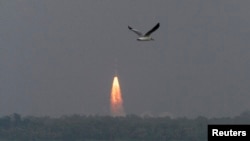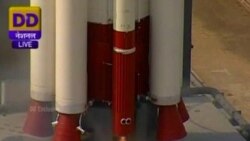ANDHRA PRADESH, INDIA —
The Chief of India's Space Research Organization (ISRO), K. Radhakrishnan says the country's maiden mission to the red planet has successfully completed its first stage, as the launch rocket placed the Mars Orbiter spacecraft precisely into an elliptical orbit around the Earth.
India on Tuesday (November 5) successfully launched its first rocket to Mars, aiming to put a satellite in orbit around the red planet at a lower cost than previous missions and potentially positioning the emerging Asian nation as a budget player in the global space race.
The Mars Orbiter Mission blasted off from Satish Dhawan Space Center in India's Sriharikota with the satellite scheduled to start orbiting Mars by September, searching for methane and signs of minerals.
The Chief of India's Space Research Organization (ISRO), K. Radhakrishnan said all went according to plan:
“Subsequent to the injection of the Mars Orbiter spacecraft into the elliptical orbit, there have been several operations performed on the spacecraft. I am happy to announce that the spacecraft is in good health and it has done the tasks that were intended to be done,” said Radhakrishnan.
“We are not in race with anybody else but we are in race with ourselves to excel in the areas chartered out for ourselves,” he added.
Only the United States, Europe, and Russia have sent probes that have orbited or landed on Mars. Probes to Mars have a high failure rate and a success will be a boost for national pride, especially after a similar mission by China failed to leave Earth's orbit in 2011.
India's ties with its neighbor are marked as much by competition as cooperation. Government scientists deny any space race, but analysts say India has stepped up its program because of concerns about China's civilian and military space technology.
The probe's 4.5 billion rupee price tag is a fraction of the cost of NASA's (National Aeronautics and Space Administration) MAVEN (Mars Atmosphere and Volatile Evolution) mission, also due to launch in November. Analysts say India could capture more of the $304 billion global space market with its low-cost technology.
Listing the benefits of the mission, Radhakrishnan said that India's space technology has assisted in disaster management operations and communication technology.
“We can proudly say in this country the space has brought the benefits of the services to the people directly to the governance system for informed decision making at all levels, whether you talk about communication infrastructure that has come in the last 12 years in the country. The ability of managing the natural resources in a better way, providing information of various development projects in the country and supporting the disaster management operations,” he added.
The Mars mission is considerably cheaper than some of India's more lavish spending schemes, including a $340 million plan to build the world's largest statue in the state of Gujarat, including surrounding infrastructure.
Even so, it has drawn criticism in a country suffering from high levels of poverty, malnutrition and power shortages and experiencing its worst slowdown in growth in ten years.
India's space program began 50 years ago and developed rapidly after Western powers imposed sanctions in response to a nuclear weapons test in 1974, spurring scientists to build advanced rocket technology. Five years ago, its Chandrayaan probe landed on the moon and found evidence of water.
The relative prowess in space contrasts with poor results developing fighter jets by India's state-run companies.
The Mars Orbiter Mission plans to search for methane in the Martian atmosphere, the chemical strongly tied to life on Earth. Recent measurements made by NASA's rover, Curiosity, show only trace amounts of it on Mars.
India's mission will also study Martian surface features and mineral composition.
India on Tuesday (November 5) successfully launched its first rocket to Mars, aiming to put a satellite in orbit around the red planet at a lower cost than previous missions and potentially positioning the emerging Asian nation as a budget player in the global space race.
The Mars Orbiter Mission blasted off from Satish Dhawan Space Center in India's Sriharikota with the satellite scheduled to start orbiting Mars by September, searching for methane and signs of minerals.
The Chief of India's Space Research Organization (ISRO), K. Radhakrishnan said all went according to plan:
“Subsequent to the injection of the Mars Orbiter spacecraft into the elliptical orbit, there have been several operations performed on the spacecraft. I am happy to announce that the spacecraft is in good health and it has done the tasks that were intended to be done,” said Radhakrishnan.
“We are not in race with anybody else but we are in race with ourselves to excel in the areas chartered out for ourselves,” he added.
Only the United States, Europe, and Russia have sent probes that have orbited or landed on Mars. Probes to Mars have a high failure rate and a success will be a boost for national pride, especially after a similar mission by China failed to leave Earth's orbit in 2011.
India's ties with its neighbor are marked as much by competition as cooperation. Government scientists deny any space race, but analysts say India has stepped up its program because of concerns about China's civilian and military space technology.
The probe's 4.5 billion rupee price tag is a fraction of the cost of NASA's (National Aeronautics and Space Administration) MAVEN (Mars Atmosphere and Volatile Evolution) mission, also due to launch in November. Analysts say India could capture more of the $304 billion global space market with its low-cost technology.
Listing the benefits of the mission, Radhakrishnan said that India's space technology has assisted in disaster management operations and communication technology.
“We can proudly say in this country the space has brought the benefits of the services to the people directly to the governance system for informed decision making at all levels, whether you talk about communication infrastructure that has come in the last 12 years in the country. The ability of managing the natural resources in a better way, providing information of various development projects in the country and supporting the disaster management operations,” he added.
The Mars mission is considerably cheaper than some of India's more lavish spending schemes, including a $340 million plan to build the world's largest statue in the state of Gujarat, including surrounding infrastructure.
Even so, it has drawn criticism in a country suffering from high levels of poverty, malnutrition and power shortages and experiencing its worst slowdown in growth in ten years.
India's space program began 50 years ago and developed rapidly after Western powers imposed sanctions in response to a nuclear weapons test in 1974, spurring scientists to build advanced rocket technology. Five years ago, its Chandrayaan probe landed on the moon and found evidence of water.
The relative prowess in space contrasts with poor results developing fighter jets by India's state-run companies.
The Mars Orbiter Mission plans to search for methane in the Martian atmosphere, the chemical strongly tied to life on Earth. Recent measurements made by NASA's rover, Curiosity, show only trace amounts of it on Mars.
India's mission will also study Martian surface features and mineral composition.










